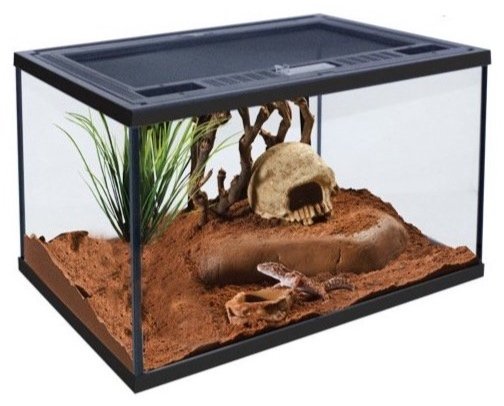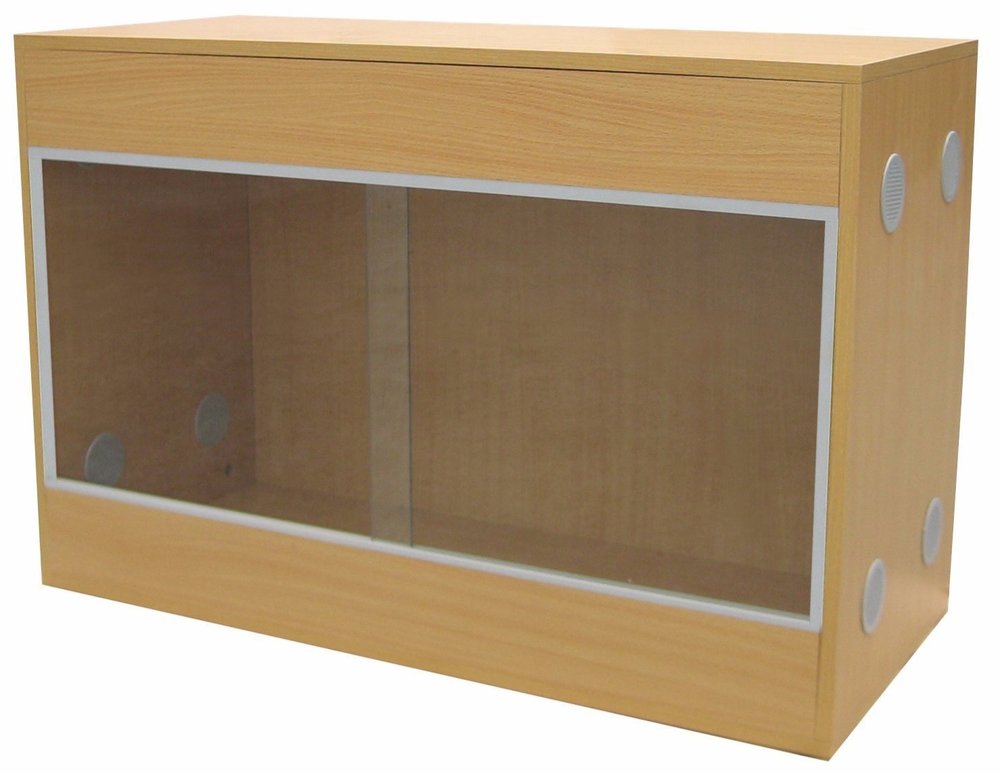What type of material is best for a reptile enclosure?
Share
In an ever-evolving world, dedicated keepers are always looking for better ways to provide a comfortable and sustainable habitat for various kinds of reptile residents. Arguably one of the most important decisions you need to make when bringing a pet reptile home is the enclosure set-up it will spend its life within.
Reptiles need specific conditions inside their enclosure, that mimic the natural environment their body is designed for, to remain healthy and active!
We wanted to give you an overview of the materials available out there that are most commonly used for reptile enclosures right now. Whether you’re in the market to buy a new enclosure or you are planning on building one yourself, we mention a few main pros and cons so you can get an idea of what type of enclosure will be the best fit for your reptile and your home.
Glass Aquariums/Terrariums:
The majority of starter enclosures you will find in general pet shops are glass. More so, many glass "reptile enclosures" that you will come across are just aquariums. These are widely available and are recommended because they have become very cost-effective for companies to produce. Small glass tanks are cheap and easy to sell to beginner reptile owners because of the low entry cost and since they have been used for so many years, deeming them a ‘classic’.
Although they provide great visibility for you, glass tanks tend to lose a lot of heat. Aquarium style reptile enclosures that are top opening can be stressful for some reptiles, since they have a natural fear and defense instinct when they see predators approaching from above.
Newer versions of glass terrariums by popular reptile brands are a better alternative to the classic aquarium (better, but still not great). They have front-opening doors and ventilation options that make them a better fit for keeping some reptiles. This option is perfect for smaller amphibians and works for some smaller reptiles that need higher levels of humidity.
Pros:
-
Full visibility for owner
-
Low entry cost
-
Hold humidity & water
-
Front opening options now more widely available
-
Available at almost any pet store
Cons:
-
Usually only available in small sizes
-
Do not retain heat
-
Visibility & reflection can stress animal out
-
Shatter on impact
-
Difficult to modify & DIY with
- Screen tops do not retain humidity
Although great for visibility, we urge you to research the habitat needs for the reptile you want to get. Consider all your options before buying a "classic" glass enclosure.
Wood/Melamine Enclosures:
Historically, wood has been one of the easiest and most versatile materials to work with. It is both an accessible and forgiving material, which has made it a very popular material to build reptile enclosures with.
Enclosures made out of wood are easy to come by and are available in many shapes and sizes. Wood is definitely the sturdiest material when it comes to building large enclosures and large habitats. Especially when a whole room conversion is required.
Wood is great if you are working with a reptile habitat that doesn’t require a lot of moisture. The main area of difficulty with wood is sanitizing it and its longevity due to cleaning and exposure to elements.
Laminated wood is a great option to make sure there is a protective layer you can sanitize, but as soon as there is damage in the layer you run an even higher risk of not seeing any rotting that happens underneath the laminate. This is especially true when using melamine or other pressed woods.
Pros:
-
Potentially low entry cost
-
Variety of sizes available
-
Easy to modify
-
Strong & sturdy for large builds
Cons:
-
Not suitable for high moisture environments
-
Mold & rot possible, especially if outer lining is damaged
-
Hard to sanitize
-
Flammable
PVC Enclosures:

Polyvinyl Chloride (PVC) is a type of plastic that can be found all around us. It has been used in many instances as a replacement for wood due to its rigidity and resistance to the elements while remaining reasonably light weight.
The way this material achieves this is through its closed cell structure. This just means PVC has millions of tiny air bubbles inside it, but they are all individual and closed so air or water cannot pass through. This makes PVC a great insulator of both heat and humidity.
One of the main differences in PVC that you will find between manufacturers is the PVC thickness. Although 1/4-inch thick is still a better alternative to glass, retaining some heat & humidity, 1/2-inch thick PVC enclosures do tend to be a lot more rigid, long lasting and insulating.
PVC is easy to work with if you need to make modifications to it or want to decorate it. It is paintable and 1/2-inch thick PVC is easy to attach enrichment and decor to inside and out of the enclosure.
Most PVC enclosures you will find are built in a similar way as wood enclosures, with traditional butt-joints or connected with a light aluminum frame if using thinner 1/8-inch or 1/4-inch PVC. Apex Reptile enclosures panels are precision machined to interlock with each other to add strength to the enclosure, even if building large, not a single panel is a simple square cut. This ensures the enclosure is structurally strong for both stacking and holding up to years of use.
Pros:
-
Insulating properties, retains heat and humidity efficiently
-
Absorbs sound and other vibration that may disturb your reptile
-
Waterproof inside and out (Won’t mold even if the surface is damaged, seams do need to be siliconed for spills)
-
Variety of sizes available, large build possible with reinforcements (Endless size and shape possibilities with Apex Reptile modular enclosures)
-
Easy to modify
-
Not flammable
- Some cost-effective options available, although with thinner, less effective PVC
Cons:
-
Surface can dent or scratch
-
Not flammable, but can melt if direct heat applied
-
Higher entry cost
(Psst…Since an Apex Reptile enclosure can expand in size instead of having to be replaced, you will save money in the long run because you won’t have to purchase a whole new enclosure every time your reptile resident grows out of it!)
Although PVC has a higher cost entry point than other more widely available enclosures, the ease of use, longevity and the insulating benefits for the reptile’s habitat has made it the current leader in reptile enclosure materials.
All the options and nuances make it really important to do your research about your reptile’s specific needs, pairing them with your own home environment. For example, if it is always cold in your home, you may not want a glass enclosure since the glass will have to battle the cold to try and keep the heat & humidity in. If you need an enclosure with high humidity you may not want a wood one because of the risk of rot down the road.
Remember to have fun while doing your research, too! There is definitely a lot of stuff to know when dealing with re-creating habitats for our cold-blooded best friends, but remember that a huge part of owning a reptile is the journey and the time you take to learn about their needs and how you can re-create them in your home, so you can both be happy and enjoy each other’s company! We encourage you to look at enclosure options and invest in the best home for your reptile family member based on their environment needs and your home nuances.
Please Remember: Be kind to yourself and your fellow keepers. Don’t be afraid to always learn new things and adjust your reptile’s habitat down the road for the better. Reptile keeping is a continuous journey that we are all learning new things about every single day!! It would be way easier if these little (and very big) creatures could explain what they want to us, but that would take half the fun out of it! ;)
So what makes an Apex Reptile enclosure unlike any other?
One of the biggest benefits to an Apex Reptile PVC enclosure is that unlike most other reptile enclosures where all the options you choose when you purchase your enclosure are set in stone, an Apex Reptile enclosure evolves with you and your pet.
It can be easily increased in size whenever your reptile outgrows it. Instead of having to buy completely new enclosures at each step of your reptile’s growth, you can upgrade the size or use the enclosure for another reptile and change the set-up completely.
Read more about what makes an Apex Reptile enclosure unique here.
See how simple it is to assemble an Apex Reptile enclosure here.


